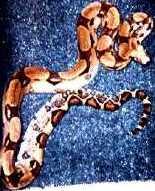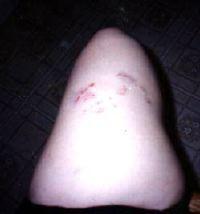Boa Basics: Columbian Red Tail Boa
Columbian Red Tail Boas
This fact sheet is for information purposes about the "Columbian Red Tail Boa" or Boa Constrictor as it is commonly known.
There are several types and sub types of Red Tail Boa including CCB or BCC or Boa Constrictor Constrictor, BCI or Boa Constrictor Imperator, BCA Boa Constrictor Amaralis or Bolivian Boa, B.C. Occidentalis or Argentine Boa to name just a few
B.C.Imperator
Diet and Nutrition
Rodents make up the greatest portion of any snakes diet. Many also relish birds so keep this in mind if you keep birds as pets! For larger adult Boas, just about any warm blooded animal will do... so keep an eye out for any other pets you may own. Your snake may not realize that it can not eat the family cat or dog, but they can still cause considerable harm, if not death to your other pets if they get loose from their caging!
That said, most snakes should be fed weekly or every two weeks at the least. Please do not fall into the myth that a snake should only be fed monthly! This only causes your pet to become testy and aggressive in their hunger, and you may be bitten when you attempt to take your snake from it's enclosure.
Do not feed prey items that are more than 1 1/2 times the diameter of your snake at his thickest point. Feeding food items larger than that may result in your Boa regurgatating his food as it begins to digest resulting in a large, sticky, smelly mess! The worst case scenario here it that the prey as it digests may become too large for the snake to regurgitate causing the death of the snake...

A simple word of caution here. This was a bite inflicted by a 7 ft African Rock Python that was being fed in the bathtub. This snake was overly anxious for the feeder, the prey animal was being fed live and jumped up in the air towards my leg. I suddenly became the fastest moving thing in the room when I saw the snake begin the strike. My rapid movement caught the snakes attention and she got me instead of the feeder! This is why any snake over 5 ft requires 2 people to handle it in case of emergency!
Small Boas may be started out on 1-2 hoppers or just weaned mice weekly eventually working up to prekilled small rats. (prekilled because rats may be too aggressive for smaller boas.
Medium Boas must be fed according to size. Feed either several large mice, up to a couple of jumbo rats weekly.
Large Boas will require either several jumbo rats or a bunny of appropriate size every 1-2 weeks depending on condition.
Always monitor your snakes condition, appearance, and activity level to help determine the amount of food to be fed. Look at the skin between the scales, if you see the white skin between the scales your snake is too fat, if you see your snakes spine or ribs your snake is way too thin.
Important Note
If at all possible please consider training your pet to take prekilled food. This is not only more humane for the feeder animal but also more humane for your pet. Many people leave live feeders with their snakes over night or for a couple of days. This practice is very dangerous as the feeder if uneaten rapidly will quickly loose it's fear of the snake and may attack and seriously injure or kill your pet! I have over the years as a reptile rescuer collected numerous gruesome photos of snakes that were brutally injured by their feeders. Many of these snakes did not survive the attacks more than a few days! Others that did survive required months of wound care and treatment to recover from their wounds both mentally and physically. A snake that has been brutalized by a live feeder will often refuse to feed for quite some time, and may require tube or force feeding; oftentimes they will never again feed on the type of animal that attacked them!
Handling
Children should NEVER have unrestricted access to medium or large reptiles! Accidents can and do happen and this could result in serious injury or death of a child! Very young children do not understand that a reptile is not a toy and often mishandle the snake resulting in injury. Remember that Boas are by their very nature wild animals, and as such unpredictable. Domestic animals are unpredictable as evidenced by the numbers of Dog bite incidents yearly. You can't predict your spouse so how can you predict the actions of a wild animal? Safety First... Supervise!
Reptiles of all types require frequent interaction by their keepers in order to remain somewhat "tame". If at all possible feed your boa in a separate enclosure or container to prevent them from associating your opening the cage door with food coming in... Once a snake makes that assumption it can take forever to retrain! The last thing you want is for a 60+ lb snake launching at the cage door in anticipation of a meal every time you open the cage!
Boas can become quite tame and docile but please exercise caution with handling to prevent injury to your family and the snake. If well cared for and socialized your pet can become a pet the entire family can enjoy.
- What To Do If A Snake Bites Your Pet
By Linda Cole It's not uncommon to run into snakes while out on the hiking trail or camping. Snakes also live in our backyards. Pets can cross paths with one, although most of the time the snake will do everything it can to avoid pets and humans....
- Small Snakes For Exotic Pet And Their Diet
These small snakes are affordable exotic pets to keep because they require minimal expenses for their food and maintenance. Spotted Python (Antaresia maculosa) Image Source The beautiful Spotted Python is a non-venomous snake of Northern Australia....
- The World’s Most Colorful Medium-sized Slender Snakes For Exotic Pets
If you don’t like large and small colorful snakes for pet, you can consider colorful medium-sized snakes for pet. Here’s a list of colorful medium-sized slender snakes for you to choose from. Green Unicorn (Rhynchophis boulengeri) Image Source The...
- World’s Most Beautiful, Colorful And Highly Recommended Small Exotic Snake Pets
Many species of snakes are extremely beautiful and colorful. They also make good pet. Be sure to select the colorful but non-venomous species if you want to have a colorful snake for a pet. Here are the prettiest non-venomous snakes which are awesomely...
- Future Snake Owners: Questions You Should Ask Yourself
Owning an exotic pet is exciting and different from the normal everyday pets you see like a dog or a cat. I was a proud owner of a ball python that I named Sage. He was a great pet and eventually I had to find him a new home because of different reasons....
